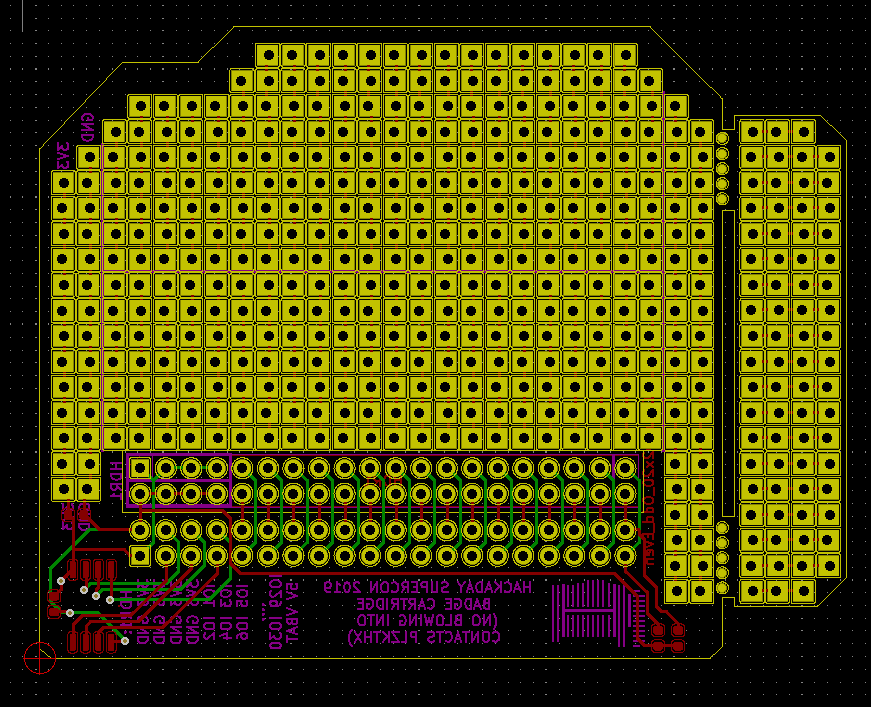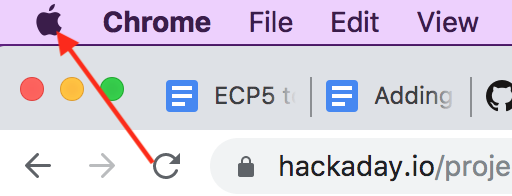-
Quickstart Information
11/04/2019 at 05:51 • 0 commentsItems you'll find useful to bring for badge hacking:
- Required:
- Laptop computer (Linux, Mac, or Windows)
- MicroUSB cable
- Suggested:
- USB-to-Serial cable (printf is your friend)
- Replacement AA Batteries. Although we will have extras on hand, this badge is power hungry and avid badge hackers may want to have a few extra sets on hand. NOTE: it is possible to power the badge through the JTAG header but you MUST remove the batteries before doing so
- PMOD hardware if you have it. The badge has one PMOD footprint and further expansion is available via the 40-pin cartridge
Getting Your Programs Onto the Badge
- The badge has a bootloader that allows you to flash your bitstreams to the FPGA via the USB port
- Badge will enumerate as mass storage. C programs can be copied via this method and will appear on the badge app menu
- Required:
-
Hardware Overview
11/04/2019 at 05:51 • 0 comments- Lattice LFE5U-45F FPGA is an ECP5 with 45k LUTs
- 2x Lyontek LY68L6400 64 Mbit SRAM chips
- Winbond W25Q128JVSIQ 128 Mbit NOR flash chip
- 480x320 Color LCD
- Mono-audio (solder the speakers available in the badge hacking area to J3)
- 8 user buttons
- 40-pin cartidge slot
- Cartridges include flash chips that will be automatically loaded when plugged in
- MicroUSB port
- HDMI port
- 2x SAO v1.69bis X-treme! headers
- 1x PMOD footprint (solder the headers available in the badge hacking area)
- It appears the silkscreen numbering for the I/O pins on this footprint is backward. More information on this soon to come.
- IRDA module
Accessing Hardware from Userspace
The most comprehensive and up-to-date documentation on hardware registers is found in the mach_defines.h file. Here is the cartridge I/O info from that file:
/** General I/O input register. Bits 29-0 reflect the values of the corresponding lines on the cartridge I/O connector. */ #define MISC_GENIO_IN_REG (17*4) /** General I/O output register. Bits 29-0 set the values of the cartridge lines that are selected as outputs. */ #define MISC_GENIO_OUT_REG (18*4) /** General I/O output enable registers. Set 1 to any of the bits 29-0 to make the corresponding line into an output. */ #define MISC_GENIO_OE_REG (19*4) /** Write 1 to set register. Any write of 1 will set the corresponding bit in MISC_GENIO_OUT_REG to 1. */ #define MISC_GENIO_W2S_REG (20*4) /** Write 1 to clear register. Any write of 1 will set the corresponding bit in MISC_GENIO_OUT_REG to 0. */ #define MISC_GENIO_W2C_REG (21*4) /** Extended I/O input register. The bits here reflect the values of the corresponding lines on the cartridge I/O connector: (ToDo: insert mapping here) Bit 31 reflects the status of the input-only USB VDET line, which is high when a +5V voltage is on the USB VBUS line. */Cartridges
You will find the cartridge specification here: https://github.com/Spritetm/hadbadge2019_protoboard
For ease of use, here are images of the board and schematic:
![]()
![]()
-
Hardware Peripherals for C Programs
11/04/2019 at 05:50 • 0 commentsThe most comprehensive information on hardware peripherals available to C programs is found in the through comments of the mach_defines.h file of soc/ipl/gloss
Buttons
Buttons may be read from a register; the bits in this register go high when the corresponding button is pressed. Button names begin BUTTON_ and end with: UP, DOWN, LEFT, RIGHT, A, B, SELECT, START.
if ((MISC_REG(MISC_BTN_REG) & BUTTON_RIGHT)) { //Do something when right button is pressed. }Upcounting Timer
A 60 Hz upcounting timer is available. Higher resolution timers are in the works too. Implement this function to easily read this counter:
uint32_t counter60hz(void) { return GFX_REG(GFX_VBLCTR_REG); }Additional time and delay utilities are available from the badge time module.
#include "badgetime.h"Following example set by Arduino, badge time provides a way to retrieve a 32-bit milliseconds count and a way to delay a given number of milliseconds.
uint32_t now = millis(); // Number of milliseconds since badge power-up. delay(1000); // Wait one secondIn addition to delay, badge time also provides convenience functions to perform several other popular types of wait. While waiting, these functions will service system background tasks.
wait_for_button_release(); // Returns once user releases all buttons wait_for_button_press(BUTTON_RIGHT); // Returns when user presses given button(s) while (doing something on every frame) { uint32_t current_frame = GFX_REG(GFX_VBLCTR_REG); // Do what we need to do wait_for_next_frame(current_frame); // Service background tasks until next frame needs to be drawn. }Apps with a tight loop without wait would need to periodically call delay with count of zero to ensure the background tasks are not starved.
delay(0); // Service background tasks and return as soon as possibleRandom Number Source
Hardware random number generator can be read via this register:
MISC_REG(MISC_RNG_REG)
LEDs
LED control is provides by this register for most of the functionality for most of the LEDs on the badge. Note that some LEDs can't initially be accessed by software.
MISC_REG(MISC_LED_REG)=0xF;
-
Graphics Engine Overview for C Programs
10/22/2019 at 13:38 • 0 commentsA tile-based graphics engine containing several layers allows for complex manipulations. The most comprehensive information on how this system works is found in the through comments of the mach_defines.h file of soc/ipl/gloss
Layers from Top to Bottom:
- Sprite layer
- Tile layer B
- Tile layer A
- Background Layer
Tileset Details:
The graphics engine is based on tile sets that are 256x512px in size, containing 16x16 pixel tiles which are indexed left-to-right beginning at the top. Tilesets are limited to a 16-bit color palette.
Writing to Tile Layers:
Each tile layer is 64x64 tiles in size, although the screen is 30x20 tiles in size. When a tile layer is enabled, any changes to that layer will be immediately viewable.
Moving Tile Layers:
As noted, tile layers are larger than the screen. These can be offset. Tile layers wrap around the screen so by filling all 64 slots and then offsetting the layer in that direction you effectively create infinite scrolling.
Scaling and Distorting Tile Layers:
More to come. See main.c of the IPL for working examples.
Working with the Sprite Layer:
The sprite layer is not yet fully available. See main.c in IPL and in the Flappy app for some working examples.
-
FPGA Programming Information
10/22/2019 at 13:38 • 0 commentsThis documentation is a work in progress.
-
Audio Subsystem
10/22/2019 at 13:38 • 1 commentThe audio is totally FPGA. There is a digital output pin, run through an RC lowpass filter, that feeds an amplifier. Your mission, should you choose to accept it: solder a speaker on to pins J3 on the lower lefthand side of the front. (We'll bring the soldering irons and speakers. Or you could go with a pin-header.)
The rest is done in gateware. There is a 14-bit, 24 MHz sigma-delta DAC with a few mixers that feed into it. For direct PCM/sample output, you simply write samples to memory and they get played.
But there's also a full-blown twelve-voice polyphonic synthesizer on board, vaguely inspired by the C64's SID chip, but with a lot more going on. Each voice has configurable attack and release rates, and is capable of running by itself for a predetermined duration once triggered. The result? You tell a voice to play for so long at this pitch and it happens automagically. Your software can get back to work.
Naturally, all of this is implemented in "hardware" inside the FPGA itself, so if you want to add some exotic features, just get hacking.
-
ecp5 Toolchain Install
10/22/2019 at 13:36 • 0 commentsFor Mac OSX (not tested on Catalina):
These are ecp5 toolchain instructions for Mac OSX and above.
This has been tested with High Sierra, and has not been tested with Catalina
Go to the apple symbol in the top left >> About this Mac to check what version OS you have.
![]()
Go here: https://github.com/xobs/ecp5-toolchain/releases/latest and grab the toolchain for your OS.
The badge uses a DFU bootloader by @Sylvain Munaut . You need dfu-util to interface with this; a binary is provided in the toolchain archive you just downloaded.
You’ll need to add the ecp5 toolchain to your path. This is how.
Test that your toolchain is working by putting yosys and then nextpnr-ecp5 in the terminal prompt.
If these work, your toolchain is installed.
Troubleshooting
Check your path.
For Debian
Coming Soon.
For Windows 10
Coming Soon.
-
Restore DFU Bootloader
10/22/2019 at 13:36 • 0 commentsProcedure to repair a damaged badge DFU (Device Firmware Update) partition.
Parts needed:
- OpenOCD compatible JTAG adapter hardware. (Output shown below were from using a Segger J-Link.)
- Computer with OpenOCD installed.
- Micro USB cable for connecting computer to badge.
- Computer with DFU utility installed. (Debian-based Linux distros can install with `sudo apt install dfu-util`)
- Hackaday Superconference 2019 Badge.
- Bootloader files "bootloader.svf" and "bootloader.bit" from the "Files" section of this project.
Procedure:
- Turn on badge while holding SW7 and SW8.
- Nothing visible on LCD. (If you see DFU screen, damaged DFU is probably not the problem, but you can go through this procedure anyway if you choose.)
- Verify computer attached via micro USB port does not see USB device. (If it does, again damaged DFU is probably not the problem.)
- Connect to badge via JTAG with OpenOCD. (If it does not connect, there are problems beyond DFU.)
Info : JTAG tap: ecp5.tap tap/device found: 0x41112043 (mfg: 0x021 (Lattice Semi.), part: 0x1112, ver: 0x4)
- Initialize OpenOCD, upload "bootloader.svf" to badge RAM, then exit.
> init > svf bootloader.svf [... lots of text trimmed ...] svf file programmed successfully for 58 commands with 0 errors > exit
- You should see DFU screen at this point, but it is only running from RAM and will disappear if the badge is restarted.
- But we should now see a DFU device over the micro USB port, and can use it to write bootloader to flash memory storage.
- Use "dfu-util -l" to list all available locations Look for "Bootloader" and note its number (in this example, 5)
dfu-util 0.9 Copyright 2005-2009 Weston Schmidt, Harald Welte and OpenMoko Inc. Copyright 2010-2016 Tormod Volden and Stefan Schmidt This program is Free Software and has ABSOLUTELY NO WARRANTY Please report bugs to http://sourceforge.net/p/dfu-util/tickets/ Found DFU: [1d50:614b] ver=0005, devnum=62, cfg=1, intf=0, path="1-2", alt=5, name="Bootloader", serial="e4692895a72b5c23" Found DFU: [1d50:614b] ver=0005, devnum=62, cfg=1, intf=0, path="1-2", alt=4, name="Cartridge main FS region", serial="e4692895a72b5c23" Found DFU: [1d50:614b] ver=0005, devnum=62, cfg=1, intf=0, path="1-2", alt=3, name="Cartridge IPL region", serial="e4692895a72b5c23" Found DFU: [1d50:614b] ver=0005, devnum=62, cfg=1, intf=0, path="1-2", alt=2, name="Cartridge ECP5 bitstream", serial="e4692895a72b5c23" Found DFU: [1d50:614b] ver=0005, devnum=62, cfg=1, intf=0, path="1-2", alt=1, name="RISC-V firmware (IPL)", serial="e4692895a72b5c23" Found DFU: [1d50:614b] ver=0005, devnum=62, cfg=1, intf=0, path="1-2", alt=0, name="ECP5 bitstream (SoC)", serial="e4692895a72b5c23"
- Upload 'bootloader.bit' to that location specified via the "-a" parameter.
dfu-util -d 1d50:614a,1d50:614b -a 5 -D bootloader.bit
- Once uploaded, the DFU should be back up and running and ready to accept a new SOC, IPL, etc.
DFU mode device DFU version 0101 Device returned transfer size 4096 Copying data from PC to DFU device Download [=========================] 100% 279463 bytes Download done. state(2) = dfuIDLE, status(0) = No error condition is present Done!
2019 Hackaday Superconference Badge
FPGA Running RISC-V Core in a Game Boy form factor
 Lutetium
Lutetium

